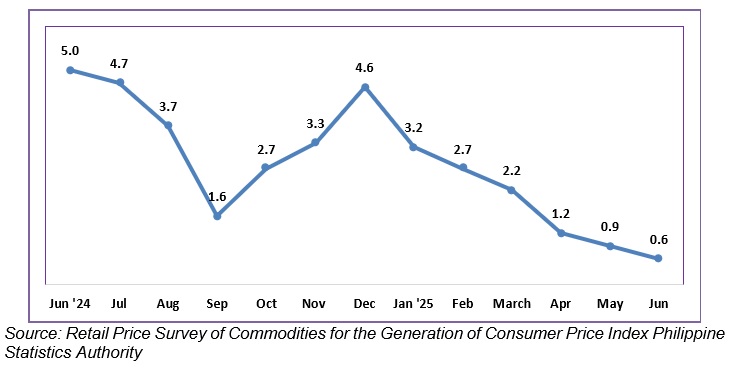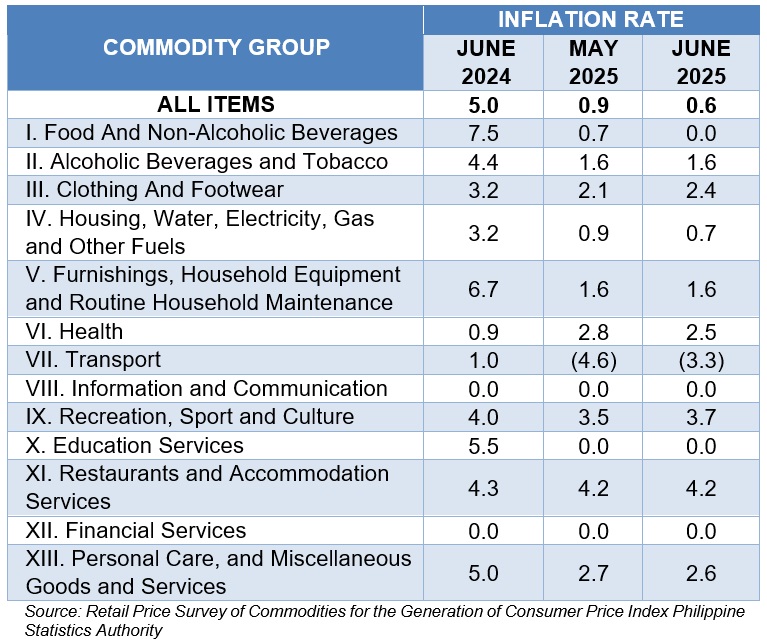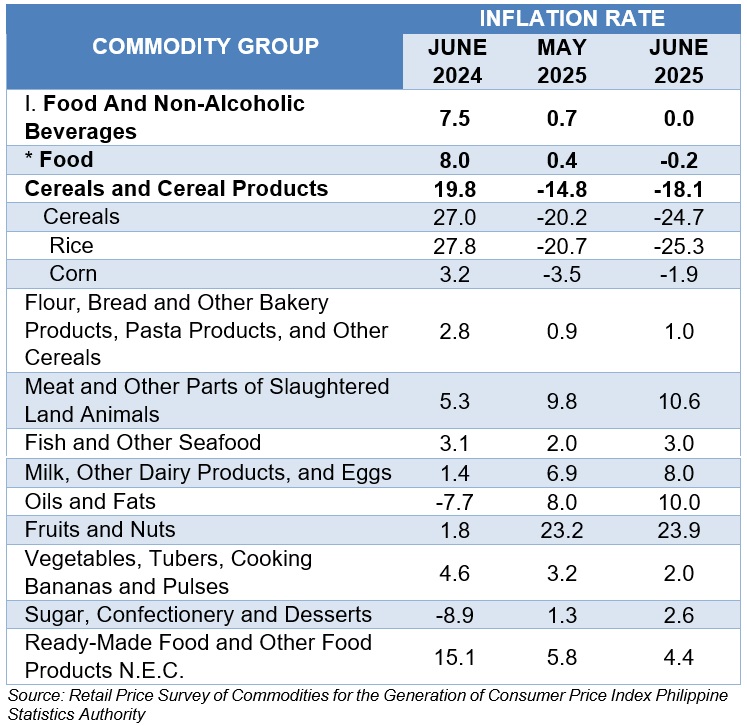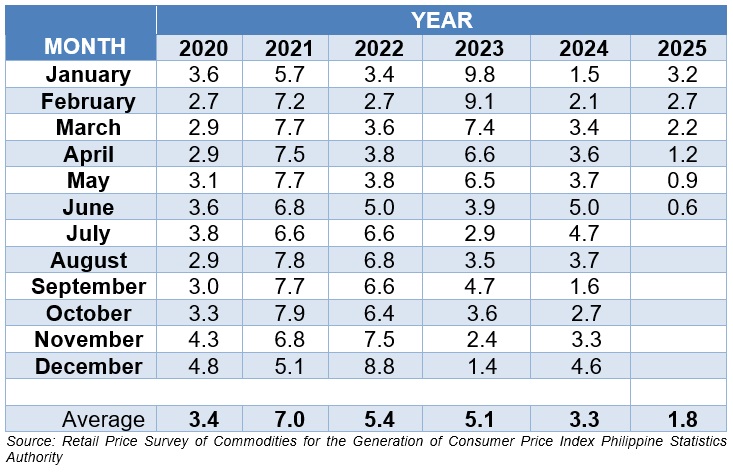Figure 1. Inflation Rates, Nueva Vizcaya, All Items (2018=100)

In June 2025, the year-on-year headline inflation rate in Nueva Vizcaya declined to 0.6 percent, marking a slowdown from 0.9 percent recorded in the previous month. This also represents a significant decrease of 2.8 percentage points when compared to the 4.4 percent inflation rate observed in the same month of the previous year, June 2024.
Meanwhile, the province’s average inflation rate for the first six months of 2025 (January to June) was stood at 1.8 percent, indicating a relatively stable price movement within the period. (Figure 1)
Table 1. Year-on-year Changes of the Consumer Price Index in Percent
in Nueva Vizcaya by Commodity Group
June 2024, May 2025 and June 2025
(2018=100)

The main drivers in the downward trend inflation for all income households in June 2025 were as follows; (Table 1)
Food and non-alcoholic beverages, 0.0 percent from 0.7 percent;
Housing, Water, Electricity, Gas and Other Fuels, 0.7 percent from 0.9 percent;
Health, 2.5 percent from 2.8 percent; and
Personal Care, and Miscellaneous Goods and Services, 2.6 percent from 2.7 percent
In contrary, three (3) commodity groups recorded an upward trend inflation rates in the year-on-year increase of index:
Clothing and Footwear, 2.4 percent from 2.1 percent;
Transport, -3.3 percent from -4.6 percent;
c. Recreation, Sport and Culture, 3.7 percent from 3.5 percent.
Meanwhile, six (6) commodity groups either retained their inflation rates from the previous month or had a zero percent annual rates:
Alcoholic Beverages and Tobacco, 1.6 percent from 1.6 percent;
Furnishings, Household Equipment and Routine Household Maintenance, 1.6 percent from 1.6 percent;
Information and Communication, 0.0 percent from 0.0 percent;
Education Services, 0.0 percent from 0.0 percent;
Restaurants and Accommodation Services, 4.2 percent from 4.2 percent; and
f. Financial Services, 0.0 percent from 0.0 percent.
Table 2. Consumer Price Index for All Income Households in
Nueva Vizcaya
June 2024, May 2025 and June 2025
(2018=100)

The inflation rate for the food index in the province stood at -0.2 percent in June 2025, marking a decrease of 0.6 percentage points from 0.4 percent in May 2025, and an 8.2 percentage point drop from 7.5 percent in June 2024 (Table 2).
The downward trend in the food index inflation rate was mainly driven by decreases in several food subgroups:
Vegetables, tubers, plantains, cooking bananas and pulses, 2.0 percent form 3.2 percent; and
b. Ready-made food and other food products, 4.4 percent from 5.8 percent.
However, seven (7) food groups recorded an upward trend in inflation rates, indicating price increases in those categories.
Flour, Bread, and Other Bakery Products, Pasta Products, and Other Cereals, 1.0 percent from 0.9 percent;
Meat and other parts of slaughtered land animals, 10.6 percent from 9.8 percent;
Fish and Other Seafood, 3.0 percent from 2.0 percent;
Milk, other dairy products and eggs, 8.0 percent from 6.9 percent;
Oils and Fats, 10.0 percent from 8.0 percent;
Fruits and Nuts, 23.9 percent from 23.2 percent; and
g. Sugar, confectionery and desserts, 2.6 percent from 1.3 percent
Meanwhile, two (2) food group showed negative inflation rate:
Rice, -25.3 percent from -20.7 percent; and
b. Corn, -1.9 percent from -3.5 percent.
Table 3. Year-on-year Rates in Nueva Vizcaya
All Items in Percent
January 2020 – June 2025
(2018=100)

Table 3 illustrates the year-on-year inflation rates in Nueva Vizcaya from January 2020 to May 2025 based on the 2018 Consumer Price Index (CPI) base year. Over this period, inflation exhibited a fluctuating trend, with the highest average inflation rate recorded in 2021 at 7.0 percent, followed by 5.4 percent in 2022 and 5.1 percent in 2023. A notable slowdown began in 2024, with the average rate dropping to 3.3 percent, and continued into 2025, where the January to May average stood at just 1.8 percent.
The inflation rate peaked in January 2023 at 9.8 percent, reflecting significant price increases during that time, likely due to external economic pressures and post-pandemic effects. Conversely, May 2025 recorded one of the lowest inflation rates in the five-year period at 0.9 percent, down from 3.7 percent in May 2024 and 7.7 percent in May 2021. This consistent decline suggests easing inflationary pressures and possibly more stable pricing conditions in the province during the first half of 2025.
DEFINITIONS AND CONCEPTS
Price
Is the amount or value paid in exchange for the commodity or a service rendered.
Retail Consumer Price
refers to the price at which a commodity is sold in small quantities for consumption.
Market Basket
a term used to refer to a sample of goods and services that are commonly purchased and bought by an average Filipino household.
Consumer Price lndex (CPl)
it is an indicator of the change in the average retail prices of a fixed basket of goods and services commonly purchased by an average Filipino household. lt shows how much on the average, prices of goods and services have increased or decreased from a particular reference period known as base year.
lnflation Rate
is an indicator derived from the CPl. lt refers to the annual rate of change or the year-on-year change of the CPI expressed in percent. lnflation is interpreted in terms of declining purchasing power of money.
Weight
a value attached to a commodity or group of commodities depending on the magnitude of its contribution to the index.
Base Period
a reference date at which the index is equal to 100. Base year is 2018.
lndex Methodology
a Laspeyre's formula: fixed base year and weights.
Purchasing Power of the Peso (PPP)
the measure of how much the peso in the base period is worth in the current period.
Percentage Change
is a simple mathematical concept that represents the degree of change over time. lt is used for many purposes in finance, often to represent the price change of a security.
Headline lnflation
measures changes in the cost of living based on movements in the prices of a specified basket of major commodities. lt refers to the annual rate of change or the year-on-year change in the Consumer Price lndex (CPl).
sgd
JOEL P. BASCO
(Supervising Statistical Specialist)
Officer-in-Charge
